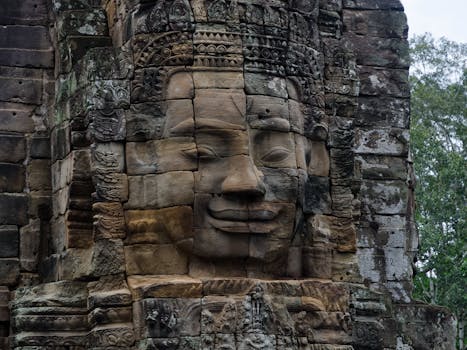The Temples of Angkor Wat
The Temples of Angkor Wat are a stunning reminder of the Khmer Empire's greatness. Located in Cambodia, these ancient structures draw visitors with their detailed carvings, tall spires, and rich history. As a UNESCO World Heritage site, Angkor Wat is not only an architectural gem but also a spiritual sanctuary that has endured through centuries.
Built in the early 12th century, Angkor Wat was initially dedicated to the Hindu god Vishnu before transitioning into a Buddhist temple. The construction is credited to King Suryavarman II and spans over 400 acres, making it one of the world's largest religious monuments. The temple complex showcases classical Khmer architecture, featuring extensive bas-reliefs and a moat symbolizing the mythological Mount Meru surrounded by oceans.
Today, Angkor Wat is a major cultural and religious center, attracting millions of tourists annually. It offers a unique window into Cambodia's history and its lasting cultural practices. With its combination of historical richness and visual beauty, Angkor Wat remains a must-visit destination for anyone interested in history, architecture, or spirituality.
The Historical Significance
Angkor Wat's origins trace back to the early 12th century during King Suryavarman II's reign. This era marked the peak of the Khmer Empire’s power in Southeast Asia. Initially dedicated to Vishnu, reflecting the king's Hindu faith, the temple gradually became a Buddhist site by the end of the 12th century.
Thousands of workers and artisans meticulously crafted Angkor Wat's sandstone blocks. These blocks were transported from quarries over 50 kilometers away via an elaborate network of canals. The precision with which these stones were cut and assembled continues to amaze experts today.
The temple’s design is symbolic, representing Mount Meru, considered the center of the universe in Hindu and Buddhist cosmology. Its five towers mimic Meru's peaks, while its moat represents the surrounding ocean. The extensive bas-reliefs depict scenes from Hindu epics like the Ramayana and Mahabharata, as well as historical events from King Suryavarman II's reign.
Architectural Marvels
Angkor Wat’s architectural brilliance is awe-inspiring. The temple displays classical Khmer architecture with large-scale bas-reliefs, symmetrical layouts, and towering spires. The central tower rises to 65 meters (213 feet), dominating the skyline and offering breathtaking views of the surrounding jungle.
The intricate carvings on the walls depict various deities, celestial nymphs known as apsaras, and scenes from epic tales. These carvings are not only artistically impressive but also serve as historical records, providing insights into ancient Khmer culture and religious practices.
Another notable feature is the gallery containing over 1,200 square meters of bas-reliefs that narrate stories from Hindu mythology. Visitors can spend hours exploring these galleries, each corner revealing new details about life during the Khmer Empire.

Preservation Efforts
Maintaining Angkor Wat's grandeur is challenging. Over the centuries, natural elements like rain, wind, and vegetation have worn down the structures. Human activities such as looting and vandalism have also posed significant threats.
In recent decades, international organizations like UNESCO have collaborated with Cambodian authorities to preserve this heritage site. These efforts include restoring damaged sections, preventing further degradation, and managing tourist activities to minimize impact.
The Cambodian government has established strict guidelines for conservation work to ensure historical accuracy. This involves using traditional methods and materials wherever possible to preserve authenticity.
Visiting Tips
A visit to Angkor Wat can be overwhelming due to its vast size and rich history. Here are some tips to make your visit more enjoyable:
- Time Your Visit: Early mornings or late afternoons are ideal times to visit to avoid crowds and catch stunning sunrise or sunset views.
- Hire a Guide: A knowledgeable guide can provide valuable insights into the history and significance of various structures within the complex.
- Dress Appropriately: As a religious site, it's essential to dress modestly. Lightweight clothing that covers shoulders and knees is recommended.
- Stay Hydrated: The Cambodian climate can be hot and humid; carry water bottles to stay hydrated throughout your visit.
- Pace Yourself: Given its vast expanse, it’s wise to allocate at least two days to explore Angkor Wat thoroughly.
A Glimpse into Local Culture
Beyond its architectural splendor, Angkor Wat offers a window into Cambodian culture. Interacting with local vendors selling souvenirs or sampling traditional Cambodian dishes at nearby eateries can enrich your experience.
The nearby town of Siem Reap serves as a gateway to Angkor Wat and boasts vibrant markets where you can purchase local crafts such as silk scarves, wooden carvings, and silver jewelry. Engaging with locals provides insights into their way of life and traditions passed down through generations.
A Look at Visitor Statistics
*Decrease due to COVID-19 pandemic restrictions.| Year | Visitors (millions) | Revenue (USD millions) |
|---|---|---|
| 2015 | 2.1 | $60 |
| 2016 | 2.2 | $65 |
| 2017 | 2.5 | $75 |
| 2018 | 2.6 | $80 |
| 2019 | 2.7 | $85 |
The Future of Angkor Wat
The future preservation of Angkor Wat hinges on balancing tourism with conservation efforts. As visitor numbers continue to rise post-pandemic lockdowns (source: UNESCO.org ) , sustainable tourism practices become crucial in ensuring this ancient site remains intact for future generations.
The Cambodian authorities are exploring measures such as limiting daily visitor numbers during peak seasons implementing strict guidelines for tour operators encouraging eco-friendly practices among tourists.